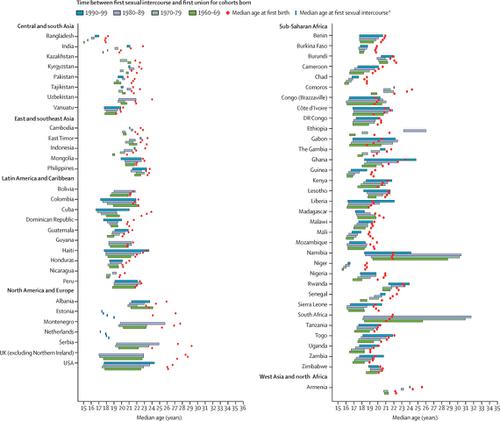The Lancet Global Health ( IF 34.3 ) Pub Date : 2020-03-09 , DOI: 10.1016/s2214-109x(20)30060-7 Emma Slaymaker 1 , Rachel H Scott 1 , Melissa J Palmer 1 , Luigi Palla 2 , Milly Marston 1 , Lianne Gonsalves 3 , Lale Say 3 , Kaye Wellings 4

|
Background
A quarter of a century ago, two global events—the International Conference on Population and Development in Cairo, and the Fourth World Conference on Women in Beijing—placed gender equality and reproductive health and rights at the centre of the development agenda. Progress towards these goals has been slower than hoped. We used survey data and national-level indicators of social determinants from 74 countries to examine change in satisfaction of contraceptive need from a contextual perspective.
Methods
We searched for individual-level data from repeated nationally representative surveys that included information on sexual and reproductive health, and created a single dataset by harmonising data from each survey to a standard data specification. We described the relative timings of sexual initiation, first union (cohabitation or marriage), and first birth and used logistic regression to show the change in prevalence of sexual activity, demand for contraception, and modern contraceptive use. We used linear regression to examine country-level associations between the gender development index and the expected length of time in education for women and the three outcomes: sexual activity, demand for contraception, and modern contraceptive use. We used principal component analysis to describe countries using a combination of social-structural and behavioural indicators and assessed how well the components explained country-level variation in the proportion of women using contraception with fractional logistic regression.
Findings
In 34 of the 74 countries examined, proportions of all women who were sexually active, not wanting to conceive, and not using a modern contraceptive method decreased over time. Proportions of women who had been sexually active in the past year changed over time in 43 countries, with increases in 30 countries; demand for contraception increased in 42 countries, and use of a modern method of contraception increased in 37 countries. Increases over time in met need for contraception were correlated with increases in gender equality and with women's time in education. Regression analysis on the principal components showed that country-level variation in met contraceptive need was largely explained by a single component that combined behavioural and social-contextual variables.
Interpretation
Progress towards satisfying demand for contraception should take account of the changing context in which it is practised. To remove the remaining barriers, policy responses—and therefore research priorities—could require a stronger focus on social-structural determinants and broader aspects of sexual health.
Funding
UNDP/UNFPA/UNICEF/WHO/World Bank Special Programme of Research, Development and Research Training in Human Reproduction.


























 京公网安备 11010802027423号
京公网安备 11010802027423号